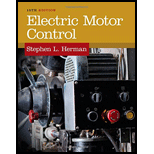
Concept explainers
Explain the procedure to engage and disengage the magnetic clutch.
Explanation of Solution
Discussion:
The clutches provide smooth start for the motors and engage the large motors to their loads. The clutches are able to control electrically. The clutches are categorized as single-face clutch and multiple-face clutch.
The single-face clutch consists of two discs that are field member and armature member. The field winding disc (field member) is an electromagnet. The field member and the armature member are brought together by applying the current to the field winding disc through slip rings (collector). The friction is produced when the current is applied to the field member and that friction tightly pulls the field member toward the armature member. That is, the clutches are engaged by applying the current to the field member through slip rings.
The field member and the armature member are
Refer Figure 56-3 in the textbook for the principle of operation of electrically controlled clutches.
Conclusion:
Thus, the procedure to engage and disengage the magnetic clutch is explained.
Want to see more full solutions like this?
Chapter 56 Solutions
Electric Motor Control
- NO AI PLEASE WILL REJECTarrow_forwardDon't use ai to answer I will report you answer. Please give explanation for both correct options and incorrectarrow_forward14:00 APP Voi) 5G 鼷浴醵郯興47% atheva.cc/index/index/index.html The Most Trusted, Secure, Fast, Reliable Cryptocurrency Exchange Get started with the easiest and most secure platform to buy, sell, trade, and earn Cryptocurrency Balance:1000.00 Recharge Withdraw Message About us BTC/USDT ETH/USDT EOS/USDT 83259.00 1841.46 83259.00 +1.02% +0.08% +1.02% Operating norms Symbol B BTC/USDT Latest price 24hFluctuation 83259.00 +1.02% ETH/USDT 1841.46 +0.08% B BTC/USD illı 83259.00 +1.02% Home Markets Trade Record Mine О <arrow_forward
- Pastner Brands is a calendar-year firm with operations in several countries. As part of its executive compensation plan, at January 1, 2024, the company issued 480,000 executive stock options permitting executives to buy 480,000 shares of Pastner stock for $38 per share. One-fourth of the options vest in each of the next four years beginning at December 31, 2024 (graded vesting). Pastner elects to separate the total award into four groups (or tranches) according to the year in which they vest and measures the compensation cost for each vesting date as a separate award. The fair value of each tranche is estimated at January 1, 2024, as follows: Vesting Date Amount Fair Value Vesting per Option: December 31, 2024 25% $ 3.90 December 31, 2025 25% $ 4.40 25% $ 4.90 25% $ 5.40 December 31, 2026 December 31, 2027 Required: 1. Determine the compensation expense related to the options to be recorded each year 2024-2027, assuming Pastner allocates the compensation cost for each of the four…arrow_forwardJOB UPDATE Apply on- Jobswood.com OR Search "Jobswood.com" on Google COMPANY JOB PROFILE JOB LOCATION WEB ENGINEER GOOGLE MULTIPLE CITIES (FRESHERS) AMAZON SOFTWARE DEV ENGG MULTIPLE CITIES COGNIZANT SYSTEMS ENGINEER CHENNAI ZENSAR FRONTEND DEVELOPER BENGALURU ORACLE AUTOMATION ENGINEER BENGALURU DIGITAL OCEAN SUPPORT ENGINEER HYDERABAD IBM APPLICATION DEVELOPER HYDERABAD INDIAMART WORK FROM HOME MULTIPLE CITIES AMAZON RECRUITER HYDERABAD GE HEALTHCARE TRAINEE ENGINEER BENGALURUarrow_forwardJOB UPDATE Apply on Vinkjobs.com OR Search "VinkJobs.com" on Google Company Name Job Profile Job Location CISCO Software Engineer Bengaluru Accenture Associate (Freshers) Chennai Trellix Developer Bengaluru Verizon SDET Bengaluru Allerin Test Engineer Mumbai Sutherland SQL/.Net Developer Chennai Bottomline DevOps Engineer Multiple Cities IQVIA HRIS Specialist Bengaluru BYJU's Associate Multiple Cities Spring Works Executive WFH (Remote)arrow_forward
- Don't use ai to answer I will report you answerarrow_forwardDon't use ai to answer I will report you answerarrow_forwardI have a problem getting the time domain of system S, can you plz show me from where I should start until find the time domain equation of the system to transfer it to z-domain.arrow_forward

 Electricity for Refrigeration, Heating, and Air C...Mechanical EngineeringISBN:9781337399128Author:Russell E. SmithPublisher:Cengage Learning
Electricity for Refrigeration, Heating, and Air C...Mechanical EngineeringISBN:9781337399128Author:Russell E. SmithPublisher:Cengage Learning EBK ELECTRICAL WIRING RESIDENTIALElectrical EngineeringISBN:9781337516549Author:SimmonsPublisher:CENGAGE LEARNING - CONSIGNMENT
EBK ELECTRICAL WIRING RESIDENTIALElectrical EngineeringISBN:9781337516549Author:SimmonsPublisher:CENGAGE LEARNING - CONSIGNMENT Delmar's Standard Textbook Of ElectricityElectrical EngineeringISBN:9781337900348Author:Stephen L. HermanPublisher:Cengage Learning
Delmar's Standard Textbook Of ElectricityElectrical EngineeringISBN:9781337900348Author:Stephen L. HermanPublisher:Cengage Learning



